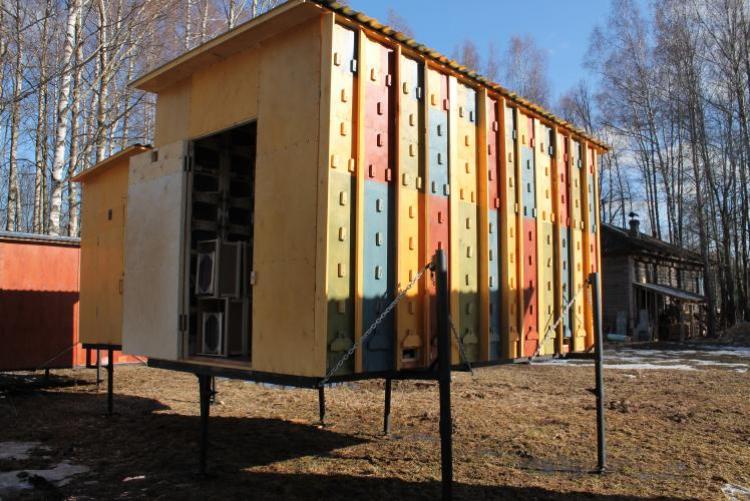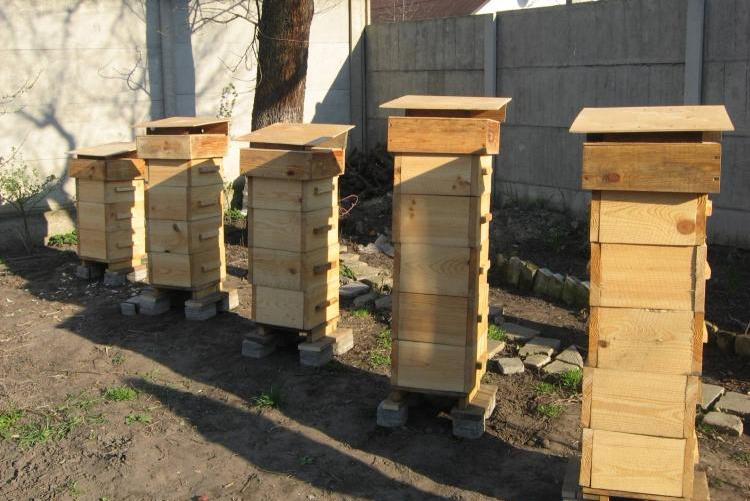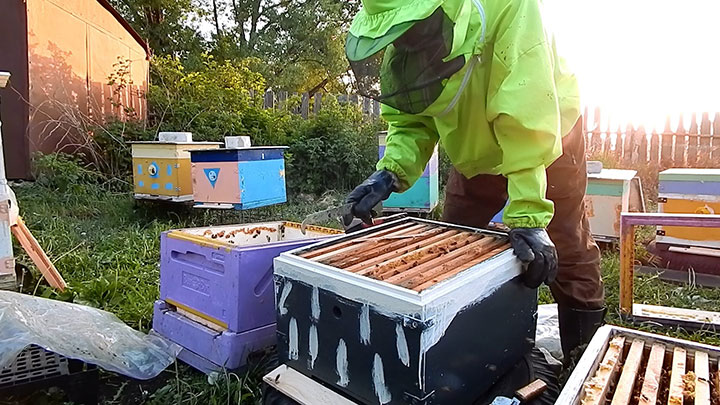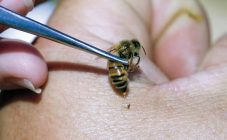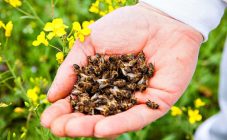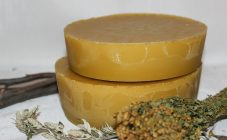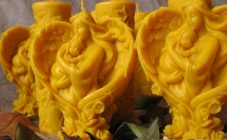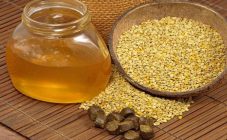Content:
In the wild, bee colonies live in hollows, crevices and other places hidden from view. Beekeeping is an old type of trade. Initially, people mined honey right in the forests. Later, bee hives were invented to keep honey bees.
What types are there
Alpine hive
Designed by the French beekeeper Roger Delon. In fact, this is a natural hive in a hollow that meets all the needs of the natural habitation of insects. Before creating the structure, the scientist followed the habits and habits of bees for many years. The buildings are located one above the other, so visually the house has a pyramidal shape. There are no partitions, grilles or ventilation holes inside. Air circulation occurs naturally through the air passage from the bottom. Alpine bee hives have special frames without a bottom and side bar. They are replaced by a wire frame. The construction is economical, does not need expensive insulation. In winter, the hive is covered with polyethylene. The bottom of the hive is made of a board 3 cm thick. The inside is impregnated with linseed oil, and the outside with paint containing aluminum. At the top of the hive, a drinker with a sweet liquid or syrup is installed, divided into 2 trays, with protrusions in the lid.
Beehive boa
It has small dimensions, therefore it is suitable for small apiaries. The frame is 11 cm * 28 cm thin but wide. In the upper part along the entire length there is a longitudinal hole, into which the foundation is placed. Cover material - plywood or chipboard. There is a 3 cm wide cavity inside the lid, which can be insulated with foam. On the side there is a ventilation hole with a diameter of 1.3 cm. The case accommodates 9 frames. The bottom is removable for easy transport, insect care and ventilation, and protection from ticks. The simple configuration of the hive allows the bees to be served quickly.
Great Russian beehive
Designed and designed by V.E.Baran. It can be made from dry coniferous wood with a thickness of 3.5 cm (for the outer walls) and 2.5 cm (for the inner walls). The flat roof with a skid plate is galvanized with iron. Nest frames measuring 30 cm * 60 cm are equipped with a ridge along the inner wall to strengthen the structure. The Great Russian bee hive contains only 12 frames, combining the convenience of bees living on the principle of a natural hollow and comfortable removal of frames with honey by the beekeeper.
Cassette bee hive
Allows to significantly reduce the incidence. Thanks to the thin internal partitions, the bees independently maintain the necessary microclimate. The material for making the hive is pre-treated with wax, so the insects' immunity increases. The hive has double walls, since each cassette has its own walls, and the common box also has walls. The cassettes move easily thanks to the side skids.
A narrow-high hive has its own distinctive features:
- Frames are arranged vertically;
- The device of a hive for bees with horizontal combs allows you to transfer wintering more comfortably due to the ease of movement straight up and the convenient location of the feeder;
- The dimensions of the hives inside directly affect the size of the frame;
- In the spring, the uterus is at the top of the hive. As the temperature rises, it can be easily moved lower;
The hive is made of high quality birch plywood up to 3.7 cm thick. The hive drawing is similar to the others and includes:
- Flat roof;
- The bottom is made of birch plywood 1 cm thick and pine planks 2 cm thick;
- Nest and plug-in moving frames;
- Ceilings.
Finnish beehive
Has become popular in recent years. The Finns were the first to decide to make a beehive from heat-insulating material - expanded polystyrene. Beehive-bibox consists of buildings of different heights: Dadan - 31 cm, Langstroth - 24 cm and semi-branded Dadan - 15.5 cm. 4 slats are supplied for each body. One body can accommodate 10 frames. At the end of the apiary season, the hive can consist of 8 hives. Airtightness and hygiene are maintained with polymer strips. The bottom of the hive has a taphole and an aluminum mesh for ventilation and protection from harmful insects. In addition, the hive is equipped with an anti-fighting system and a grate for collecting propolis.
Hive Cebro
It is not insulated or transported for wintering, since its structure allows maintaining the microclimate familiar to bees. Ventilation hatches with grilles are integrated on the cover. The cover is attached with hinges. The side wall can be folded back completely. The pallet is retrieved through a hinged hatch. The fully equipped hive has a mini-veranda in the upper entrance. For the winter, the hive is covered with a casing against precipitation. According to the configuration, it is a frame multi-body hive with 14 frames.
Hive Varre
Has an interesting cover design. This is a gable roof with ventilation in the attic, separated from the main hive by boards, so rodents cannot get inside. A beehive is made from a board from 20 mm to 60 mm, while the dimensions of the house remain unchanged.
The main part of the hive is vertical sections with a height of 21 cm and a cross-section of 30 cm. Wax stripes are installed inside, indicating the direction of building honeycombs for bees.
Kuznetsov's universal hive
Allows to keep up to 4 families. It is assembled into grooves from a 25 mm board. Inside it is divided into compartments by perpendicular partitions. Maximum capacity is 36 frames. The outer casing is missing. There are carrying handles.
Vitvitsky's hive
Multi-body frameless design with a volume of 60 liters. It has a pyramidal shape, which is favorable for wintering. The main feature of the hive is that the family masters only the volume of the hive for which it has enough strength. As the family develops, the area of development increases and vice versa.
PPU hive
Has become popular in recent years, when the use of synthetic materials has become common. Polyurethane foam has been used as a building material for about 30 years. The advantages of such a hive:
- Does not rot, has high moisture resistance;
- Has good thermal conductivity and sound insulation;
- Strong and durable;
- Safe and environmentally friendly;
- Easy to care for, easy to transport due to its low weight and completely collapsible structures;
- Transforms up and down, depending on the size of the family.
Hive design
Materials for making beehives
Most often, for the construction of a hive they use:
- Wood is a classic material that insects like very much, as it is of natural origin. Most often, linden, aspen, as well as conifers (fir, spruce, pine) are used for manufacturing. The main disadvantage is that insulation is required for the winter.
- Plywood is an environmentally friendly and durable material. Poorly tolerates moisture and requires constant care.After processing with acrylic paint and insulation with polyurethane, it becomes more functional.
- The polyurethane foam material has high thermal conductivity, so bees grow faster. PPU hives are very light. The material creates a high protective barrier against moths.
- Expanded polystyrene is a budget option, while such a hive does not need insulation. The main disadvantage is the fragility of the structure. Moreover, the poor quality of raw materials impairs the quality of honey.
Basic structure
- The body is the basis of the hive. Here are the honeycombs;
- The store is located under the building. Bees put honey here. It should be warm here, so double walls are usually made;
- The roof cover protects from precipitation, creates a favorable microclimate;
- Components - frames, insulation, dividers, hinges, ventilation and more.
Universal sizes
- Distance between adjacent frames - 37.5 mm;
- Tap hole diameter - 12.5 mm;
- The distance between the bottom bar and the bottom is not less than 20 mm;
- The distance between the back (front) wall and the side strips is 7.5 mm;
What is Nucleus
Bee cores are a small hive that includes 1-2 frames for brood and feed. They are necessary for the preservation of the uterus and her babies in the winter. Most often, 1 or 2 queens and up to 1000 worker bees live in the nucleus. For the manufacture of walls, fiberboard is most often taken. Each core must have at least 2 tap holes. If the family is strong, then you can make a 4 entrance. The walls must be made double, the bottom and roof must be single. Each such house can accommodate 6 longitudinal frames or 12 transverse ones.
Core advantages:
- Increase the productivity of the apiary;
- Timely family renewal by replacing the uterus;
- Increase in the volume of extracted honey.
There is no universal hive. Each beekeeper chooses the most convenient option for himself. The most important thing when choosing a hive is the quality of the material. Low-grade structures get very wet and serve little. In warm dry houses, bees give much more honey, get sick less and winter better. Also, do not forget about the timely care of the hive.

